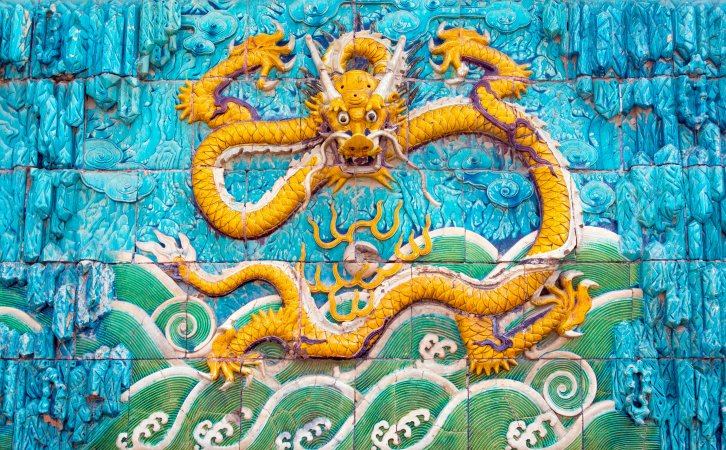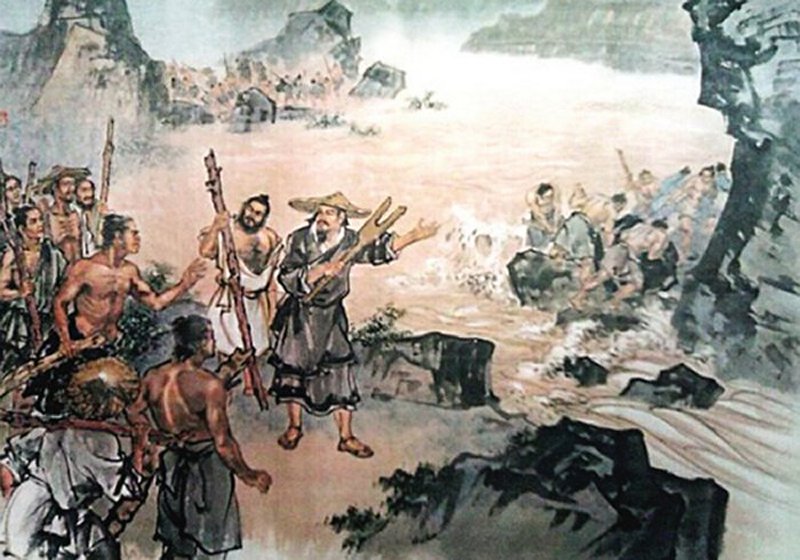A. Sutherland – AncientPages.com – In ancient Chinese mythology, Gong Gong (also King King, Gongong) was a god of destruction and the one who ruled water. However, he made it in such a destructive manner that many considered him to be a demon or monster, and his disastrous behavior towards the planet Earth was unacceptable.

Credit: Markus Thoenen – Adobe Stock
He was described as a powerful, several hundred miles high monster that once smashed his head against Buzhou Mountain, one of eight pillars (Eight Pillars of the Sky) holding up the sky. Having been damaged by Gonggong, it no longer separated the Earth and the Heaven for the proper distance.
One episode tells how Gong Gong made a crack in the sky with his horn and changed the sun’s orbit. He disturbed the globe’s balance and caused the rivers to rise with great, disastrous floods on Earth. Blamed for various cosmic catastrophes, Gong Gong ends up being killed or sent into exile.
Quarrel Between The Fire God Zhu Rong And Water God Gong Gong
One myth is related to Gong Gong, Zhu Rong, the Fire God and ruler of the Universe, and the goddess who was living on Earth.
Gong, an ugly, evil creature, envied Zhu Rong who had a positive influence on Earth when the sun was shining and the people could enjoy their ordinary lives.
Gong Gong decided to take control of the Universe from Zhu Rong, and these two met in a fierce battle that took place in heaven and then on Earth.
The evil Gong Gong certainly did what he could but was unable to fight and withstand the power of the sun and its terrible heat that scorched the living creatures of the sea and rivers. In a fit of fury, he smashed his head against Buzhou Mountain, one of eight pillars holding up the sky, greatly damaging it and causing the sky to tilt towards the northwest and the Earth to shift to the southeast, which caused great floods and suffering. He lost the fight with Zho Rong to claim the throne of heaven.
Legend has it that Nu Gua (Nugua), in Chinese mythology, the patroness of matchmakers also considered the goddess of creation, repaired the pillars of heaven and the broken corners of the Earth, destroyed by Gong Gong.
To accomplish her task, Nu Gua used the feet of a tortoise and melted-down stones that turned into a five-colored mixture. She also built a lovely palace that became a prototype for the later walled cities of China.
 Great Floods in China. source
Great Floods in China. source
She could not, however, repair all the damages Gong Gong caused. For example, she could not fully correct the tilted sky and Earth and alter their effects on the sun, moon, stars, and rivers in China.
In the ancient Chinese poem “Heavenly Questions” (Tianwen) poem dated to the Warring States period (ended 221 BC), Gong Gong is blamed for knocking the Earth’s axis off-center, causing it to tilt to the southeast and the sky to tilt to the northwest.
These are very serious accusations because this axial tilt is used to explain why the rivers of China generally flow to the southeast, especially the Yangzi River and the Yellow River, and why the sun, moon, and stars move towards the northwest.
Especially, the myth of Mount Buzhon is seen in Chinese folklore as the root cause of all the major rivers in China flowing to the East.
Was Gong Gong Only Credited With Devastation?
No doubt, he had a dangerous approach to water, but did he ever make something good for people and the planet Earth?
In folktales and myths of the Chinese, Gong Gong had a copper human head adorned with an iron forehead and a horn, red hair, and the body of a black dragon with a tail. He looked dangerous and was very dangerous. He was often accompanied by the gigantic and nine-headed snake Xiangliu who spat out a ᴅᴇᴀᴅly poison. According to Chinese stories, these two enjoyed each other’s company when they brought flooding and destruction.
See also: More Myths And Legends
With these myths as a background, Gong Gong is also seen as the cause of bad weather and other unusual weather phenomena.
Most of the stories portray Gong Gong as an ambitious, cruel, and vain being, this being the cause of his fury and evil. On the other hand, there are those who say that instead of a cruel tyrant, he was actually a good person and leader of ancient China who made outstanding contributions in the construction of dams and dealing with floods and other water problems.
Updated on February 22, 2022
Written by – A. Sutherland – AncientPages.com Senior Staff Writer
Copyright © AncientPages.com All rights reserved. This material may not be published, broadcast, rewritten or redistributed in whole or part without the express written permission of AncientPages.com





